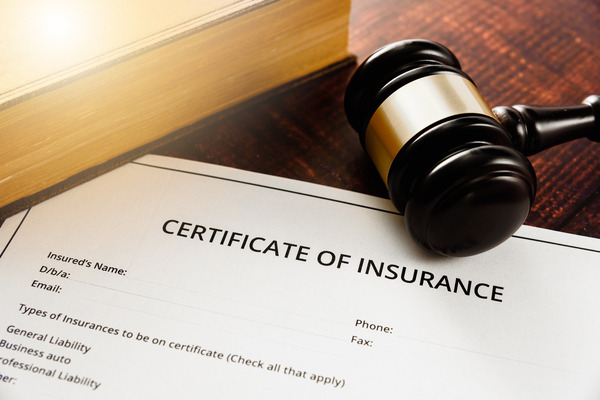Are you one of the 62% of small-to-medium enterprises (SMEs) who don’t have enough general liability insurance for their business?. You can’t predict when your business gets hit with a liability lawsuit. Claims can harm from your products, services, or on your premises. Nor can you assume that your business is safe because you haven’t had an incident in the past.
All you can do is prepare—and a comprehensive insurance policy is the only way forward.
Picture this: A customer slips on your newly-mopped floor after an employee neglects to put out a wet floor sign. Within weeks, you’re served with a lawsuit and found to be at fault. (Or you’re not at fault, but you’re out of pocket for legal defense costs anyway.)
Financial Damage
Without general liability insurance, your business can be held financially and legally liable for the damages that ensue from the unfortunate slip.
General liability insurance protects your business from claims of customer injury and property damage on your premises or caused by your products or services.
In 5 steps, here’s how to protect your business against claims of injury and damages by choosing the right insurance plan:

1. Know the basics of general liability insurance
Before choosing the right liability insurance option, it’s important to have a basic idea of how it works.
Knowing the fundamentals helps you buy the best policy for your business. But it also ensures that you know when and how to apply your coverage.
Also known as commercial general liability insurance. This type of insurance provides protection against claims of bodily or property harm at your fault on your business premises. It also covers harm due to the use of your products.
You can buy this kind of insurance as its own policy. It’s more common to package up this coverage with other business policies from your insurance provider. (General liability is important, but it doesn’t replace other critical parts of a business owner’s policy.)
2. Determine your risk and coverage needs
Spend some time researching the liability scenarios that are most common in your industry. Your business may face more sources of risk than you know. The more sources of risk your business faces, the more coverage you need on a general liability policy.
No two businesses or property owners have exactly the same risk factors or coverage needs. Meeting with an insurance specialist can help you decide what you’re looking for, whether it’s low premiums or the most comprehensive coverage.
At this stage, ensure that you leave no coverage gaps in your general liability policy. Recognize and plan every possible contingency. If you’re working with a specialist, they’ll help uncover and fill the gaps you can’t see.
Coverage Needs
Your business’ unique coverage needs depends on factors such as:
- The business type, including whether it’s high-risk
- The size of your business
- Your location and clientele
- Your team size and experience
- Whether you’re a sole proprietor
This step is important to repeat every fiscal year as your business grows and changes, since your coverage needs will evolve too.
For instance, your business today may focus on selling goods. If you expand your services in the future, your old policy may not necessarily mesh with the new liability needs that come with entering a client’s home.
3. Know what general liability insurance covers
General liability insurance may cover legal fees, court costs, medical expenses, and damages resulting from a claim that your products, services, or business caused harm.
That harm could take the form of:
- Third-party bodily injury: Remember the earlier example of a customer falling on a wet floor while on your business premises? That’s a perfect example of a third-party bodily injury claim. This is personal, bodily damage that the client asserts was the result of your business’ actions or negligence.
- Third-party property damage: This is any damage that your business may cause to a third party and their property. This often applies to businesses that provide services at a client’s home. If you send out roofers to a client’s home and they break a window with their equipment, then a third-party property damage suit is likely to ensue.
- Reputational harm: You could be sued by an individual or business for reputational harm. If an employee makes an offhand comment about them that’s taken as libel or slander. Conversely, an employee could sue you for reputational harm if they believe that comments you made to potential employers led to a loss of consideration for those jobs.
- Advertising injury: This type of claim takes place when someone asserts that you’ve stolen their intellectual property. Invaded their privacy, slandered their name, or infringed on their copyright. If you’ve used an image on your business website without confirming the terms of use. You could end up with a cease-and-desist from the artist.
Coverage
Not only does general liability cover the damages for these claims, but it also covers the legal defense costs. Whether your business is in the wrong or not. If a customer sues because they believe you injured them or damaged their property, your insurance policy covers you even if you’ve caused no harm.
Most general liability policies do not cover the following:
- Bodily harm to employees: Worker’s compensation insurance is a specific type of liability insurance that covers bodily harm to employees.
- Damages to autos on the premises: Most general liability policies exclude automobile damage on the premises, such as an accident in a drive-through or parking lot
- Intentionally-inflicted damages: If a consumer makes a claim based on damages that they caused intentionally, then your insurer will not cover the claim.
- Damage to business property that you own and use for business purposes: Commercial property insurance can cover these claims.
- Errors made when providing professional services: Professional liability insurance can help cover claims of negligence, misrepresentation, or bad advice.
Insurance Providers
Most insurance providers allow a la carte coverage additions, so you may be able to add services beyond the standard for your insurance plan.
That could include auto coverage, retained limits (which are similar to deductibles and enable lower premiums), or “nuisance” cases that require defense without a true liability claim.
4. Request and compare policy quotes
Once you’re aware of your business’ coverage needs and have considered any additions, you can request quotes from leading insurance providers and compare them.
You’re not necessarily looking for the cheapest general liability policy you can find. Instead, you must prioritize finding enough coverage for your unique risk level. Find the best deal that gets you all the security you need.
If you’re a high-risk business, then this is even more important, since your coverage is inherently more complicated.
Receiving quotes from multiple providers helps you make a decision based on all the facts, including premiums, policy exceptions, coverage, etc.
If you have a financial planner or broker involved with your business, include them in this part of the decision-making process. They’ll have an intimate understanding of your insurance budget and the ability to inform your decision.
5. Revisit and boost your policy annually
Your business is constantly evolving, so your general liability insurance policy needs to follow suit.
A simple policy review can help your business shore up against the unpredictable events that close thousands of doors each fiscal year. Yet it’s all too common to push this task off to next quarter (or next year).
The truth is, your business changes fast, and your risk assessments and coverage needs won’t be the same this time next year. It’s easy to end up with insufficient coverage when you never check in or make upgrades.
Ask yourself these questions about your general liability policy during your annual policy review:
- Does the policy hold up to the current risk assessment of the business?
- Is the amount of coverage still enough after a year of growth and change?
- Are you pleased with the service from the insurance carrier?
- Is the policy within budget?
- Are there any limitations or exclusions that are no longer workable?
- Does the policy contain any add-ons you don’t need any longer?
- Are there gaps in coverage that could be filled by add-ons?
Again, it’s critical to include your broker or financial planner in this conversation, as they have insight about your assets, risks, and needs that will illuminate the next year’s policy choices.
Protect your business now, not later
Letting insurance fall by the wayside is a potential death sentence for any business. It takes only one event without insurance to cause serious financial and legal damage. And no small business is immune to experiencing an insurable event.
Don’t let your business fall victim to preventable financial catastrophe when a commercial liability policy could prove to be a true safety net.
General liability insurance is the only way to shield your business from claims of bodily injury and property damage.
Now’s the time to start thinking about how general liability coverage fits into your insurance strategy. A claim could come at any time, and tomorrow it could be too late.
Have questions? Feel free to contact us!












